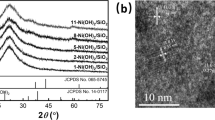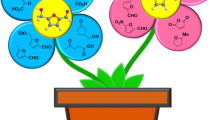Abstract
Production of pyridine derivatives from bio-based feedstocks instead of fossil fuels is a promising strategy. The development of effective heterogeneous catalysts and mild reaction systems for pyridinization of renewable biomass derivatives remains a huge challenge. In this article, a direct and environment-friendly method was reported to produce 3-hydroxypyridine from bio-based furfural in water over a Raney Fe catalyst. Raney Fe exhibited an efficient catalytic performance for activation of the aldehyde group of furfural and afforded an 18.2% yield of 3-hydroxypyridine at 120 °C with ammonia as N source. The polymerization of furfural on the catalyst in hot water was the main cause of deactivation, which was verified by the scanning electron microscope (SEM), X-ray diffraction (XRD), and N2 adsorption and desorption analysis. A possible mechanism for this reaction was also proposed. This study provides a new way for academia and industry to realize the synthesis of nitrogen-containing chemicals from biomass and its derivatives.






Similar content being viewed by others

References
Prachayasittikul S, Pingaew R, Worachartcheewan A et al (2017) Roles of Pyridine and Pyrimidine Derivatives as Privileged Scaffolds in Anticancer Agents Mini. Rev Med Chem 17:869. https://doi.org/10.2174/1389557516666160923125801
Makino K, Hasegawa Y, Inoue T et al (2019) Chemoselective Demethylation of Methoxypyridine. Synlett 30:951. https://doi.org/10.1055/s-0037-1612427
Hill MD (2010) Recent Strategies for the Synthesis of Pyridine Derivatives. Chemistry 16:12052. https://doi.org/10.1002/chem.201001100
Tschitschibabin AE (1924) Über Kondensationen der Aldehyde mit Ammonik zu Pyridinbasen. J Prakt Chem 107:122. https://doi.org/10.1002/prac.19241070110
Sagitullin RS, Shkil GP II, NosonovA AAF (1996) Synthesis of pyridine bases by the chichibabin method (review). Chem Heterocycl Com 32:127. https://doi.org/10.1007/BF01165434
Kubranová M, Jóna E, Rudinská E, Nemceková K, Ondrušová D, Pajtášová M (2003) Thermal properties of Co-, Ni- and Cu-exchanged montmorillonite with 3-hydroxypyridine. J Therm Anal Calorim 74:251. https://doi.org/10.1023/A:1026350424642
Zhang D, Qu J, Lu W et al (2010) The synthetic technology of 2-hydroxylpyridine. Hebei Chemical Engineering and Industry 33:48–49
Świątek K, Gaag S, Klier A, Kruse A, Sauer J, Steinbach D (2020) Acid hydrolysis of lignocellulosic biomass: sugars and furfurals formation. Catalysts 10:437. https://doi.org/10.3390/catal10040437
Wang J, Wang J-h, Y-m Yu (2020) Effective and safer catalyst KHSO4 for producing furfural: a platform compound. Biomass Convers Bior. https://doi.org/10.1007/s13399-019-00516-z
Grilc M, Likozar B, Levec J (2014) Hydrotreatment of solvolytically liquefied lignocellulosic biomass over NiMo/Al2O3 catalyst: Reaction mechanism, hydrodeoxygenation kinetics and mass transfer model based on FTIR. Biomass Bioenerg 63:300. https://doi.org/10.1016/j.biombioe.2014.02.014
Grilc M, Likozar B, Levec J (2014) Hydrodeoxygenation and hydrocracking of solvolysed lignocellulosic biomass by oxide, reduced and sulphide form of NiMo, Ni, Mo and Pd catalysts. Appl Catal B: Environ 150–151:275. https://doi.org/10.1016/j.apcatb.2013.12.030
Šivec R, Grilc M, Huš M, Likozar B (2019) Multiscale modeling of (Hemi) cellulose hydrolysis and cascade hydrotreatment of 5-Hydroxymethylfurfural, furfural, and levulinic acid. Ind Eng Chem Res 58:16018–16032. https://doi.org/10.1021/acs.iecr.9b00898
SU Raut, PR Bhagat (2021) Efcient photocatalytic acetalization of furfural to biofuel components using carboxyl‑functionalized porphyrin photocatalyst, under visible light irradiations. Biomass Convers. Bior https://doi.org/10.1007/s13399-021-01658-9
Uno O (2001) Production of 3-hydroxypyridines. Koei Chemical Co., Ltd., Japan
Dai G, Hu T, Wang Y (2001) Synthesis of 2-methyl-3-hydroxylpyridine. Huaxue Shiji 23:370–371
Gao Y, Ding Y (2020) Nanoporous Metals for Heterogeneous Catalysis: Following the Success of Raney Nickel. Chemistry 26:8845. https://doi.org/10.1002/chem.202000471
Zhou K, Chen B, Zhou X, Kang S, Xu Y, Wei J (2019) Selective Synthesis of Furfurylamine by Reductive Amination of Furfural over Raney Cobalt. ChemCatChem 11:5562. https://doi.org/10.1002/cctc.201901269
Weingarten R, Cho J, Conner JWC, Huber GW (2010) Kinetics of furfural production by dehydration of xylose in a biphasic reactor with microwave heating. Green Chem 12:1423. https://doi.org/10.1039/C003459B
Lomba L, Giner B, Zuriaga E, Moya J, Lafuente C (2013) Self-aggregation of liquids from biomass in aqueous solution. J Chem Thermodyn 66:131. https://doi.org/10.1016/j.jct.2013.06.020
Peleteiro S, Rivas S, Alonso JL, Santos V, Parajo JC (2016) Furfural production using ionic liquids: A review. Bioresour Technol 202:181. https://doi.org/10.1016/j.biortech.2015.12.017
Acknowledgements
We thank all reviewers and editors for reviewing the manuscript and providing valuable comments.
Funding
The authors gratefully acknowledge the financial support from the Key Project of Intergovernmental International Scientific and Technological Innovation Cooperation (2017YFE0127100), Shanghai Pujiang Program (20PJ1404800), Science and Technology Department of Xinjiang Uyghur Autonomous Region (2018D04013), the West Light Foundation of Chinese Academy of Sciences (2018-XBQNXZ-B-014), High-level Talents Introduction Project in Xinjiang Uygur Autonomous Region (2018).
Author information
Authors and Affiliations
Corresponding authors
Additional information
Publisher's note
Springer Nature remains neutral with regard to jurisdictional claims in published maps and institutional affiliations.
Supplementary Information
Below is the link to the electronic supplementary material.
Rights and permissions
About this article
Cite this article
Ren, D., Jiang, X., Zhang, N. et al. Facile pyridinization of bio-based furfural into 3-hydroxypyridines over Raney Fe catalyst. Biomass Conv. Bioref. 13, 8115–8121 (2023). https://doi.org/10.1007/s13399-021-01802-5
Received:
Revised:
Accepted:
Published:
Issue Date:
DOI: https://doi.org/10.1007/s13399-021-01802-5



